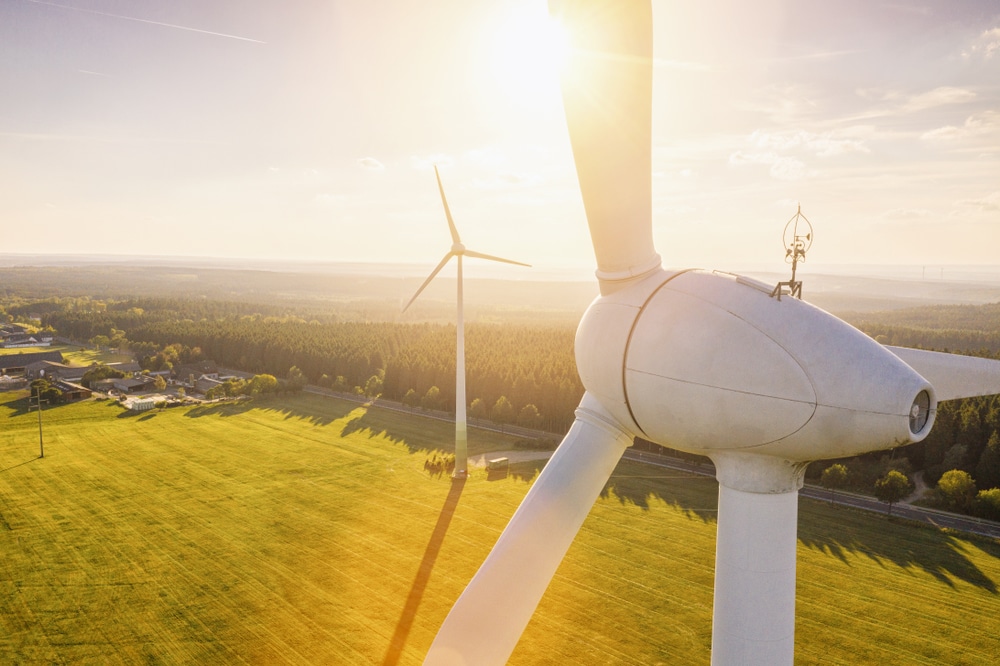Once considered as a niche segment of the clean energy industry, the renewable energy sector has now become a significant source of power in the U.S. and around the world.
As companies strive to achieve Net Zero by transitioning away from fossil fuels, they’re relying more on renewable energy sources. Renewable energy plays a crucial role in US, Europe and other wealthy nations’ energy security and sustainability pathways.
It is, therefore, not surprising that businesses and governments are incorporating renewables in their environmental or climate change strategies.
So, why are entities intensifying efforts and investing heavily on renewables in their quest to a cleaner and greener future?
This article will explain everything you need to know about renewable energy, what are its benefits and major sources or technologies. It will also identify the top companies dominating the sector and their renewable energy technologies propelling the net zero transition.
What is Renewable Energy and Why Is It Important?
Renewable energy is energy from natural sources that replenish more than they’re consumed. Solar and wind are the common sources of renewable energy; they’re abundant and are present around us.
On the other hand, non-renewable energy like fossil fuels are finite and takes millions of years to replenish. Coal, oil, and gas are non-renewable sources of energy that once burned, generate large amounts of planet-warming greenhouse gas emissions.
These GHG blankets the planet and trap the sun’s heat, heating up the Earth.
Producing renewable energy releases far lower emissions than burning fossil fuels. Moving away from fossil fuels, which currently account for the lion’s share of emissions, to renewable energy is key to addressing the climate crisis.
This sustainable energy also helps companies reduce reliance on fossil fuels and thus, cut carbon emissions significantly.
So, to avoid the worst effects of climate change, the world has to drastically reduce its GHG emissions. Clean and renewable energy can help us get us there… and it comes with plenty of benefits.
Benefits of Using Renewable and Sustainable Energy
Powering up with renewables brings a range of benefits, the major one is providing a freely available source of power.
As the sector continues to grow, it also creates a surge in job opportunities in developing and installing renewable technologies. Plus, renewables offer better and more affordable access to energy in emerging economies. Renewables are now cheaper in most countries and generate 3x more jobs than fossil fuels.
And of course, one of the biggest benefits of sourcing energy from renewables is the fact that they’re mostly clean and sustainable.
The diagram shows the major difference between renewables and fossil fuels in key aspects, including carbon content, cost, and supply. 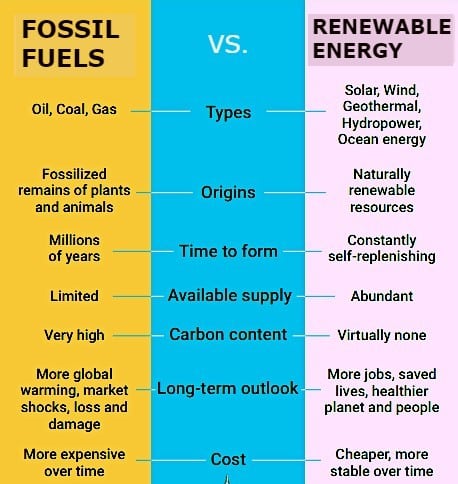
And did you know that the rate at which solar energy strikes the Earth is 10,000x more than the rate at which humans consume energy? That means it’s impossible for us to exhaust the energy that the sun provides.
It’s just that the world must invest $4 trillion annually in renewable energy by 2030 to reach net zero emissions by 2050. Still, the return on this investment will be more than 6-fold – $26 trillion!
In sum, here are the environmental and economic benefits of using renewable energy:
- Producing energy that releases less or no GHG emissions from fossil fuels and reduces air pollution
- Diversifying the energy mix and cutting reliance on imported fuels
- Creating more jobs in manufacturing, installation, maintenance, etc.
However, these benefits are not only possible with renewable sources. Nuclear power, too, is dubbed as a clean, zero-carbon energy source; it emits much lower carbon. Some favor nuclear over renewables like solar and wind because it’s a stable source that doesn’t rely on weather conditions.
Still, the pros of renewable and sustainable power sources outweigh their cons and their consumption will continue to increase sharply.
So, what are the common renewable energy sources or technologies available right now? Let’s talk about the top five ones.
What Are the Main Sources of Renewable Energy?
There are different technologies that can be used to generate renewable power but the most common ones are the following.
-
Solar Energy
Rain or shine, solar energy remains the single most abundant source of renewable power. It can be harvested during cloudy weather.
Moreover, the cost of producing solar panels has gone down substantially in the last 10 years. This makes renewable energy from the sun both affordable and often the cheapest. Not to mention that solar panels can stay up to about 30 years.
That could be longer as better materials and technologies are becoming available that make them even 1,000x more powerful. This breakthrough is courtesy of the researchers at Martin Luther University Halle-Wittenberg (MLU).
Solar technologies convert sunlight into electrical energy through photovoltaic (PV) panels or mirrors that concentrate solar radiation. While not all nations have equal access to sunlight, a considerable share to the energy mix from solar is still possible for every country.
-
Wind Energy
This type of renewable energy is infinite as long as the air moves that turns the large wind turbines. It has been around for thousands or even millions of years, even longer than solar energy.
But it has evolved and improved in generating electricity with both onshore and offshore wind energy technologies getting better. Their turbines become taller and the rotor turns bigger.
And like solar, the potential to generate power through the wind goes far more than the world’s demand for electricity. Most regions of the world are capable of deploying renewable wind energy, with offshore capacity offering huge potential.
-
Hydropower
You might be surprised to know that power from water is the largest share of renewable energy in the power sector. Hydropower can be produced either from running rivers or reservoirs of stored water.
Reservoirs of hydropower also provide drinking water, irrigation, navigation, drought control, and more. But it depends largely on stable rainfall patterns, so climate-related events like droughts can negatively impact its power generation. Small-scale hydropower is best in remote communities.
-
Geothermal/Hydrothermal Energy
Another renewable source of power comes from the inner part of the Earth – heat or geothermal reservoirs. It can be harnessed through wells or any other means.
Two kinds of this energy reservoirs are available: hydrothermal, naturally hot enough to create power, and geothermal, hot but needs improvement using hydraulic stimulation. Hot fluids that get on the surface are useful in producing power.
Generating electricity from hydrothermal reservoirs has been going on for over a century.
-
Bioenergy
This technology is quite different because it needs more processing to convert to energy. It can be produced from various organic materials known as biomass such as agricultural waste, wood, charcoal, and animal manure.
Compared to burning fossil fuels, burning biomass releases lower GHG levels. However, bioenergy won’t be good for most energy applications because large-scale use may involve significant land-use changes like deforestation. Popular applications would be in aviation as green fuels.
Current State and Outlook for Renewables
As we scramble on our feet to decarbonize the global economy, we need a new energy system that does away with fossil fuels. And clean, sustainable, and renewable sources are the key to it.
The current state of renewables tells us that this new energy is our future. In fact, renewables will account for 90%+ of global electricity capacity expansion from 2022-2027, according to the International Energy Agency.
The global energy crisis is pushing the accelerator on this renewable energy expansion. The Russian-Ukraine conflict has particularly sparked great momentum for renewables.
Moreover, disruptions in fossil fuel supply underlined the benefits of generating domestic energy from renewable sources. It alleviates energy security issues many countries face in relying on fossil fuels. Thus, national governments have and are strengthening policies that boost renewable energy like the case of China, India, the U.S., and the EU.
Higher fossil fuel prices also bolster the competitiveness of renewables, especially solar PVs and wind power against other fuels.
All these factors drive the growth in renewable energy capacity additions as seen in the chart below. Historical data shows rising new renewables capacity from 2017 to 2024.
Net RE Capacity Additions by Technology, 2017-2024
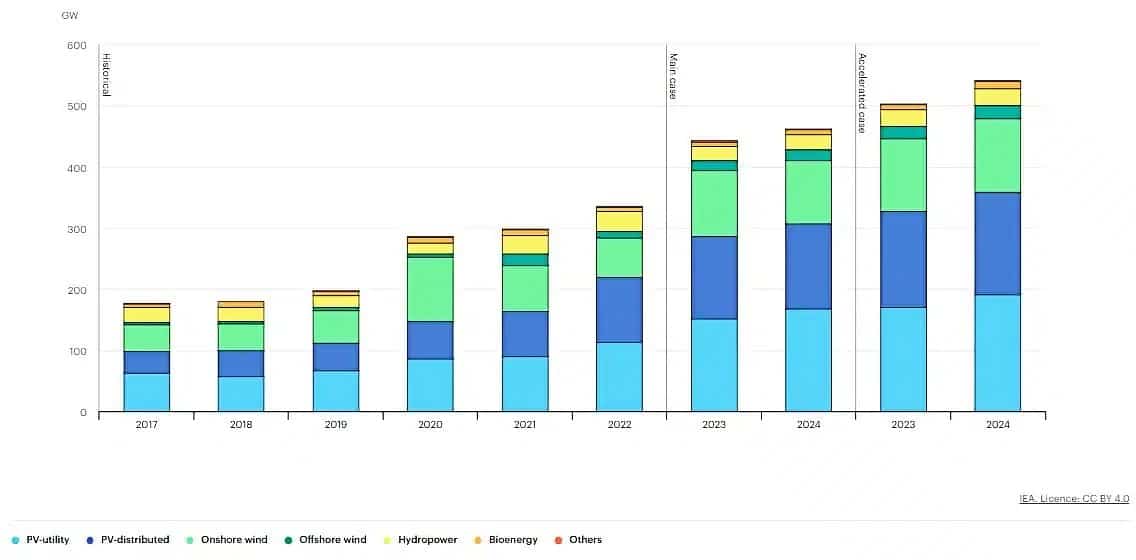
Earlier this year, the retail giant Amazon received a go signal from Indian authorities to start trading renewable energy sources in the country. The company has signed a total of 720 MW worth of energy purchasing agreements in India from different renewable sources, solar and wind.
These supports for clean and sustainable sources could be driven by the promising outlook for renewables. The IEA projections show continuous growth for this clean energy sector.
The agency estimated that renewables will become the biggest source of global electricity generation by early 2025, exceeding coal. Annual renewable capacity additions are forecast to increase continuously, hitting a record 460 GW in 2027. In an accelerated case, this capacity goes up to almost 600 GW in the same year as shown below.
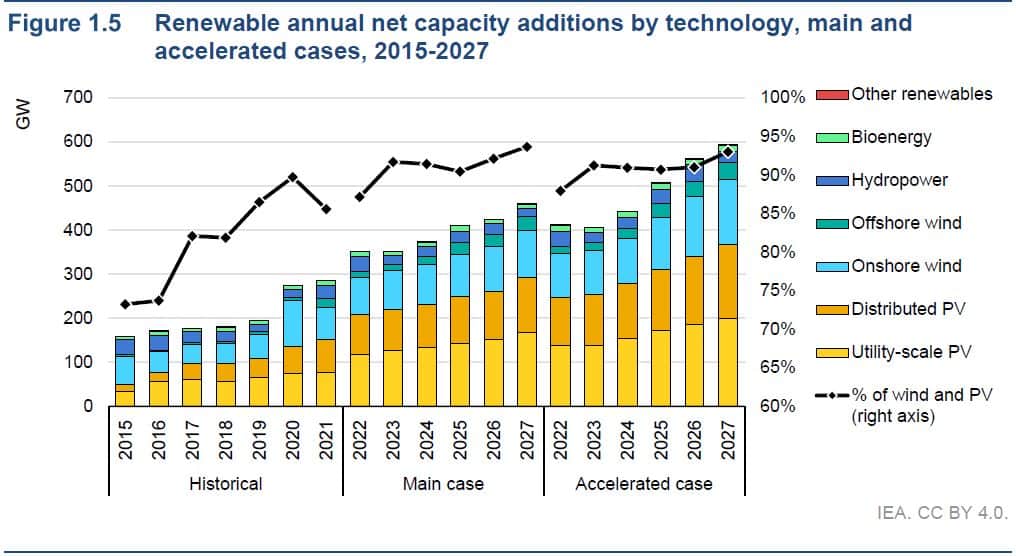
The same trend is forecasted in other developed regions and this seems to be the way forward as the world decarbonizes even more. So, who are the major players in this sector?
Four names stand out in the list of top renewable energy companies.
What Are the Top Renewable Energy Companies?
1. General Electric Co. (GE)
As a Fortune 500 company and one of the largest American corporations with an $89 billion market cap, General Electric (GE) is widely recognized for its innovations in power and renewable energy. The company has made huge strides in developing green energy solutions and became a key player in the industry.
GE has been at the forefront of wind energy technology, consistently enhancing turbine designs and improving efficiency. Here is GE in numbers when it comes to its wind energy solutions.

In addition to wind power, GE has also invested in other renewable energy technologies, such as solar power, hydroelectricity, and hybrid.
More remarkably, the top renewable energy company offers data-driven insights, expert recommendations, and advanced field services – all integrated into a single software platform. This capacity drives more revenue up, costs down, and risks lower in providing wind energy systems.
2. NextEra Energy, Inc.
Making it to the second spot is Florida-based energy solution provider NextEra Energy.
Running with a whopping $147 billion market cap, NextEra has been investing billions in developing renewable energy sources. As one of the largest renewable energy producers in the world, the company leads the charge in solar and wind energy production.
NextEra currently generates a capacity of about 30,000 megawatts from both sources. Its clients are retail and municipal electricity providers, industrial companies, and power cooperatives. With $135 billion in total assets, NextEra is indeed a leader in electricity generated from wind and solar with this coverage.
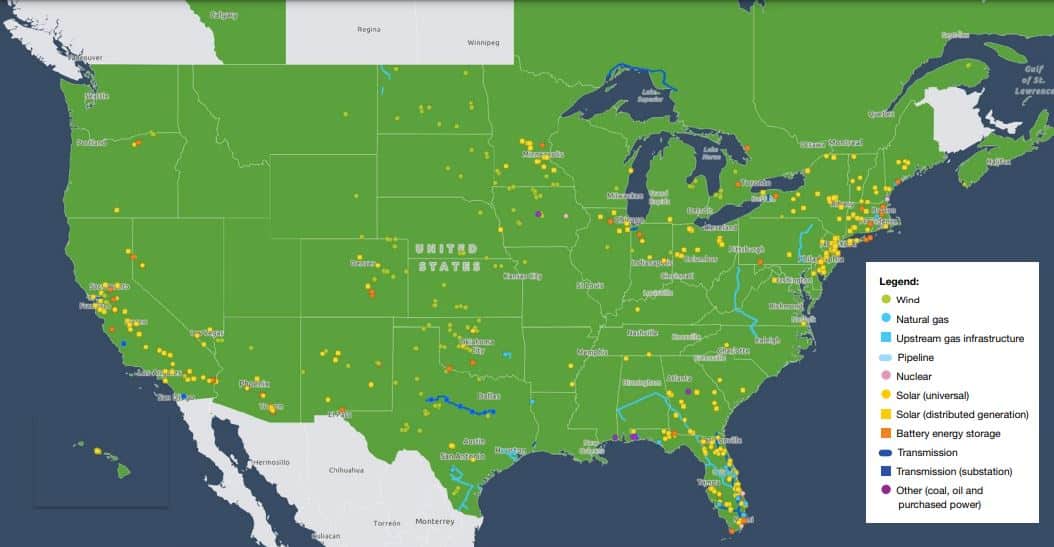
The company aims to invest up to $95 billion in American renewable energy infrastructure through 2025. It’s the same year that the firm plans to reduce its own CO2 emissions by 67% from 2005 levels.
With the slogan “a real plan for a real zero”, NextEra is helping ensure that the next energy to bring America to net zero will be clean, renewable energy.
3. Iberdrola SA
With a market cap of over $72 billion, Spain-based multinational electric utility company Iberdrola SA has more than 170 years of history. The company is a global leader in the generation, distribution, and trading of clean energy.
Iberdrola specializes in onshore and offshore wind, hydro, solar PV, and battery storage solutions. Aside from Spain, it also operates in the U.S., U.K., Mexico, Brazil, and many more countries, over 40 countries, in fact.
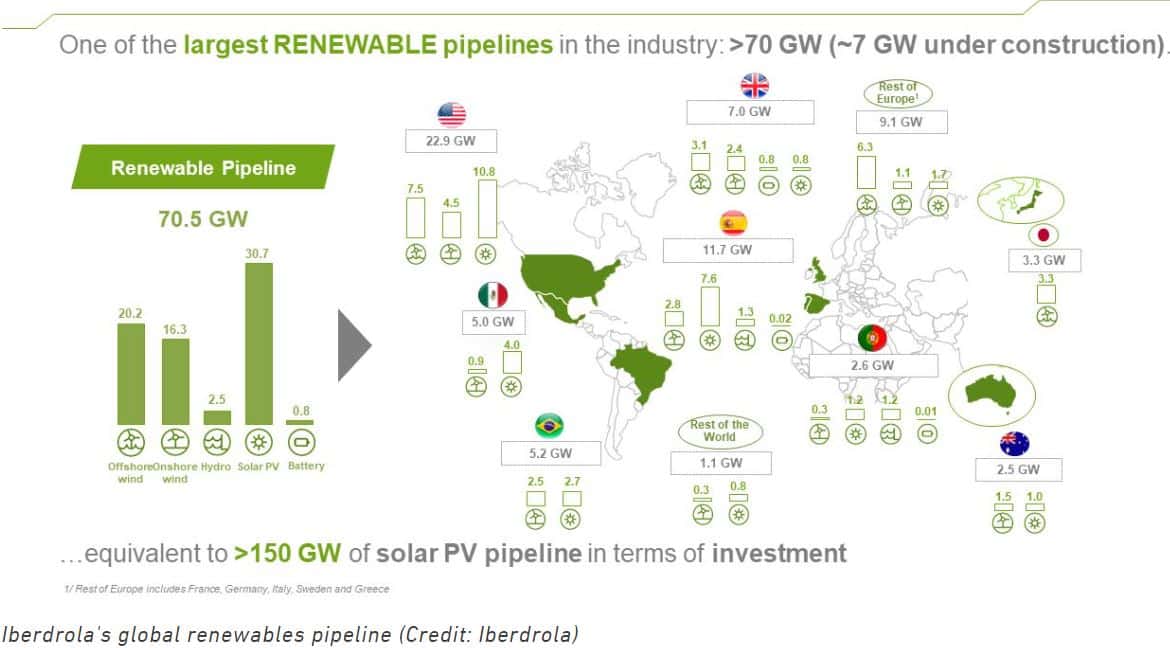
4. Orsted A/S
Renewable energy company Orsted A/S excels in developing, building, and operation of offshore wind farms. The Danish firm currently owns the prestigious title of being the world’s biggest offshore wind power developer, with a total capacity of over 7.5 GW.
Standing tall at a $36 billion market cap, Orsted A/S has established offshore wind farms in different countries, including the UK, the US, Germany, and Taiwan.
The top renewable energy company visualizes a world that runs entirely on green and renewable energy to limit climate change and power the world sustainably. With that, the company aims to achieve a 99% renewable share of its energy production by 2025.
Renewable Energy Share of Power Production
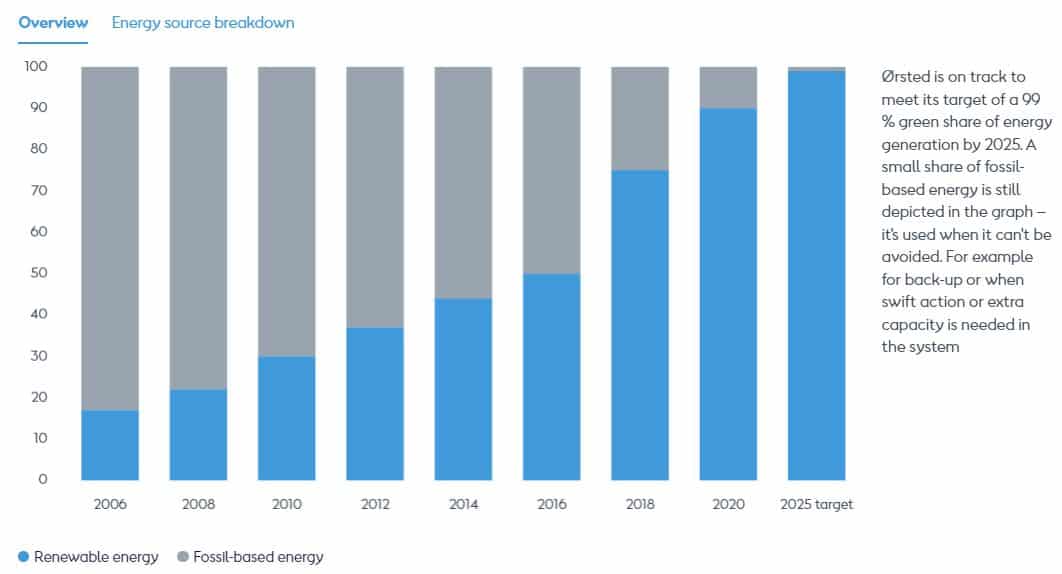
The Future Lies in Clean and Renewable Energy
Renewable energy will continue to rise unstoppably, slashing greenhouse gas emissions as it edges out fossil fuels.
Now is the pivotal time for cleaner, greener, and renewable sources of energy. Renewables are at the heart of transformations happening in the global energy system. Their growing deployment is vital for efforts to fight climate change, bring down global temperatures, and save our only planet.

